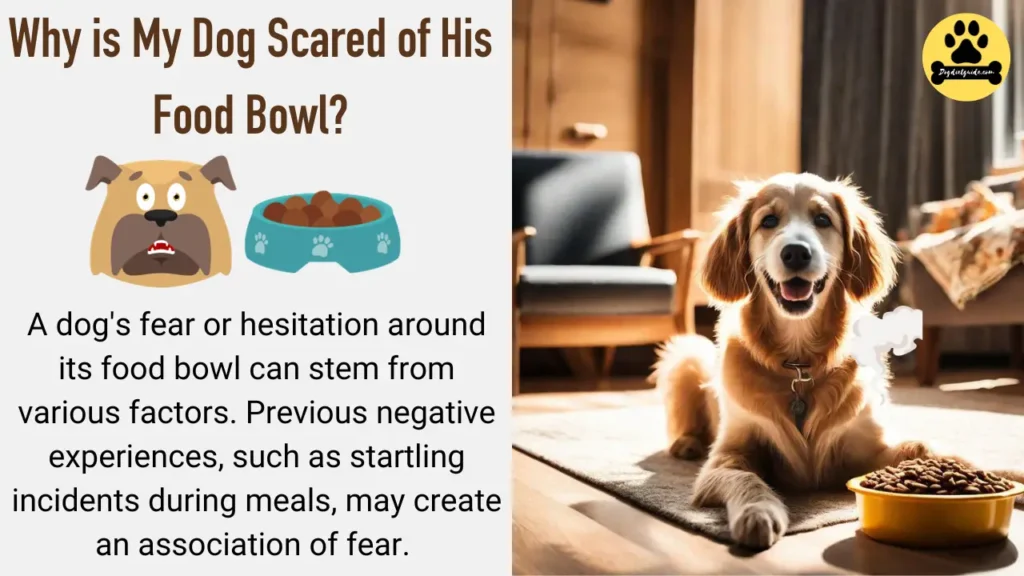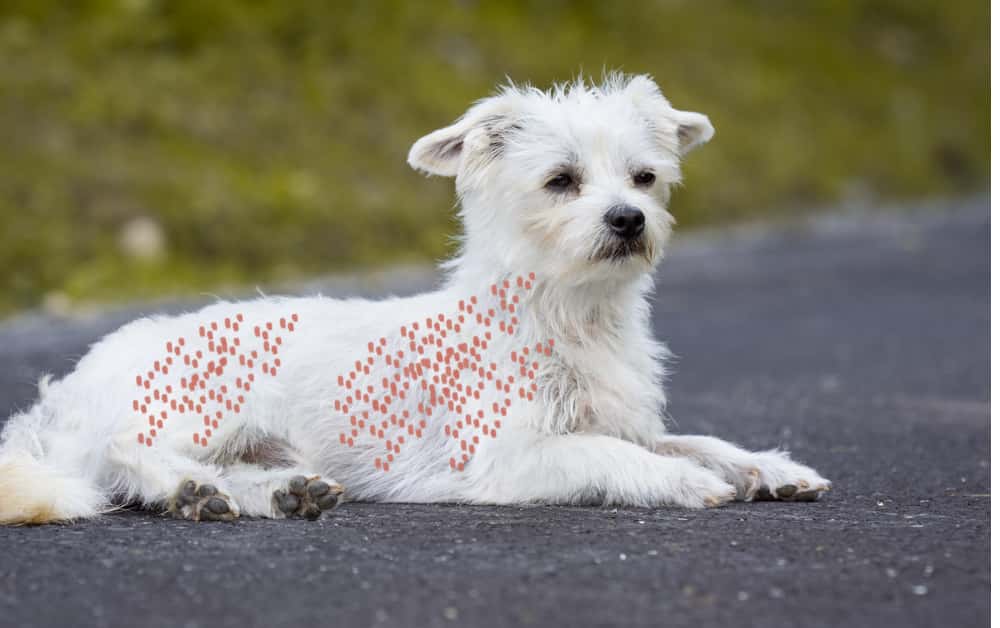Introducing the enigmatic world of canine behavior, where even the most seemingly straightforward aspects of daily life can become mysterious puzzles. You’re not alone if you’ve noticed your dog acting weird around the food bowl.
Many dog owners have experienced the perplexing scenario of a once-eager eater now approaching their meals with caution or downright fear. So, why is my dog scared of his food bowl?
Short Answer:
A dog’s fear or hesitation around its food bowl can stem from various factors. Previous negative experiences, such as startling incidents during meals, may create an association of fear. Noise sensitivity, discomfort while eating due to dental issues or pain, environmental changes, fear of dominance, and unfamiliar food can all contribute to a dog’s unease.
Why is My Dog Scared of His Food Bowl?
7 main reasons of food bowl anxiety in dogs are:
- Past Traumatic Experiences
- Past Traumatic Experiences
- Unfamiliar Surroundings
- Bowl Size and Shape
- Negative Associations
- Social Anxiety
- Medical Issues
1. Past Traumatic Experiences
Dogs, much like humans, can be deeply affected by past experiences. If your dog had a negative encounter with the food bowl, such as a loud noise or accidental bump, it might associate the bowl with fear.
Gradual desensitization by introducing positive associations can help alleviate this fear over time.
2. Past Traumatic Experiences
Some canines are more sensitive to visual or auditory stimuli. Shiny or reflective surfaces on the bowl might create glare or strange reflections that unsettle your furry friend, and your dog may back away from food.
Opting for a non-reflective or opaque bowl can help mitigate these sensory issues.
3. Unfamiliar Surroundings
Changes in the environment, such as moving to a new home or rearranging furniture, can make your dog feel insecure. This unease might extend to the food bowl area, and your puppy may develop food bowl scaring behavior.
Ensure the feeding area is consistent and comforting, providing security.
4. Bowl Size and Shape
Sometimes, your dog backs away from food when the bowl’s size, depth, or shape intimidates your pup. Experimenting with different bowl options, such as shallower dishes or wider bowls, can help your dog feel more comfortable during mealtime.
5. Negative Associations
If your dog has a bad experience during feeding, such as scolding or punishment, it may associate the food bowl with negativity, and your dog becomes scared of the food bowl.
Creating a positive and relaxed atmosphere during meals through gentle praise can help reshape these associations.
6. Social Anxiety
Dogs are social animals, and mealtime can be stressful if they feel vulnerable. Feeding in a quiet, secure space away from foot traffic can help alleviate social anxiety during meals.
7. Medical Issues
It’s crucial to rule out any potential health concerns. Pain or discomfort, particularly in the neck or mouth, can make your furry friend hesitant to approach the food bowl.
A vet check-up can help identify and address any underlying health issues.
Related Post: Can Dogs Eat Meatballs?
Addressing Food Bowl Anxiety in Dogs: Effective Strategies
Food bowl anxiety in dogs can manifest as behaviors such as guarding, growling, or becoming anxious around their food bowl. Addressing this issue ensures your dog feels comfortable and safe during mealtimes.
Here are some tips to help alleviate food bowl anxiety in dogs:
-
Hand-Feeding: Instead of using a traditional food bowl, try hand-feeding if your dog suddenly afraid of food. Hand feeding helps build trust between you and your dog and can make mealtime a positive and interactive experience.
-
Interactive Feeders: Interactive feeders or puzzle toys that dispense food. These toys make mealtime more engaging and encourage problem-solving and mental stimulation.
-
Desensitization: Gradually desensitize your canine to the food bowl by associating it with positive experiences. Start by placing treats or a small amount of food near the bowl without putting it in the bowl. Over time, move the treats closer to the bowl until your dog is comfortable eating from it.
-
Change the Location: If your dog is anxious about eating in a specific location, try moving the food bowl to a different spot. Choose a quiet and calm area where your dog feels secure.
-
Mealtime Routine: Establish a consistent mealtime routine. Dogs often feel more secure when they know what to expect. Feed your pup simultaneously and in the same manner each day.
-
Positive Reinforcement: Use positive reinforcement techniques to reward calm behavior around the food bowl. Praise and reward your dog when approaching the bowl without showing anxiety or aggression.
-
Training and Obedience: Invest time in basic obedience training. Teaching commands like “sit,” “stay,” and “leave it” can help you manage your dog’s behavior during mealtimes.
-
Consult a Professional: If your pet’s food bowl anxiety persists or is severe, consider consulting a professional dog trainer or behaviorist. They can assess the specific situation and provide personalized guidance.
-
Medical Check-up: Sometimes, changes in behavior, including food-related anxiety, can be linked to health issues. Ensure your dog is healthy by scheduling a veterinary check-up to rule out any underlying medical concerns.
Addressing food bowl anxiety may take time, patience, and consistency. It’s essential to approach the issue calmly and positively to create a comfortable and trusting environment for your dog during mealtimes.

Related Post: Can Dogs Eat Steaming Hot Food?
FAQs
Why does my dog seem scared to eat from his bowl?
Your dog may be scared to eat from his bowl due to past negative experiences, such as loud noises or discomfort while eating. It could also be related to changes in the environment or the bowl itself.
Why is my dog refusing to eat from his bowl?
Your dog might refuse to eat from his bowl if he associates it with a negative experience, or if he prefers a different feeding method. Check for any changes in the bowl, surroundings, or recent events that may be causing discomfort.
Why is my dog afraid of his water bowl?
Fear of the water bowl could stem from noise, reflections, or even water temperature. Evaluate the bowl, environment, and any recent changes to identify potential stressors.
Why is my dog whining at his food bowl?
Whining at the food bowl could indicate excitement or anticipation. It might be a learned behavior for attention or a signal that the food is not to his liking.
Should I take my dogs food away if he doesn’t eat it?
Removing your dog’s food if he doesn’t eat can create anxiety. Instead, assess possible health issues or changes in appetite, and consult your vet if needed.
Why will my dog only eat off the floor?
Some dogs prefer eating off the floor due to comfort or instinct. It’s normal as long as the food is safe and the dog is healthy.
Why my dog is scared to eat in front of me?
Your dog might be scared to eat in front of you due to anxiety, fear of judgment, or past negative experiences. Gradually build trust through positive reinforcement and a calm environment.
Final Thoughts
Understanding and addressing your dog’s fear of the food bowl requires patience, observation, and a willingness to adapt.
By identifying the root cause and implementing positive changes, you can transform mealtime into a positive and enjoyable experience for your beloved canine companion.
Remember, each dog is unique, so finding the right approach may take time, but the rewards of a happy and relaxed dog during meals are well worth the effort.










![Can Dogs Eat Blood? 7 Side Effects [Expert Opinion]](https://petskor.com/wp-content/uploads/2022/04/Webp.net-resizeimage-12.jpg)
